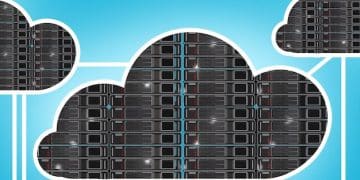Cloud Networking Latency: Achieving Sub-50ms Response in the US

Cloud Networking Latency is the delay in data transfer across cloud networks; achieving sub-50ms response times for US users involves optimizing infrastructure, reducing distance, and employing efficient protocols.
Is your cloud network slowing down your US users? High latency in cloud networking can lead to a frustrating user experience. Let’s explore how to address cloud networking latency and achieve sub-50ms response times, ensuring optimal performance for your US-based audience.
Understanding Cloud Networking Latency
Cloud networking latency refers to the time it takes for data to travel from a user’s device to a cloud server and back. High latency can significantly impact application performance, leading to slow loading times, delayed interactions, and a poor overall user experience. Optimizing latency is crucial, especially for users in the US.
Factors Contributing to Latency
Several factors contribute to cloud networking latency. It’s important to identify these factors to strategically address each one.
- Distance: The physical distance data must travel is a primary cause of latency.
- Network Congestion: High traffic on network paths slows down data transmission.
- Hardware Limitations: Outdated or poorly configured network devices can increase latency.
Addressing these factors helps improve response times and provide optimal cloud experience.
In conclusion, understanding the main factors behind latency is the key to mitigating issues and improving user experience.
The Impact of Latency on US Users
For US-based users, experiencing high latency can be particularly detrimental. The vast geographical area of the United States means that data might have to travel long distances, exacerbating latency issues. This can have several critical impacts on business productivity and customer satisfaction.
Negative Effects on Business Operations
High latency can severely impair essential business operations. Real-time collaboration tools suffer, customer service interactions degrade, and data-intensive applications stall.
- Slow Application Performance: Users experience delays and lag, leading to frustration.
- Reduced Productivity: Employees waste time waiting for applications to respond.
- Customer Dissatisfaction: Negative experiences drive customers to competitors.

Ensuring low latency is critical for maintaining productivity, client satisfaction, and overall market competitiveness in the United States.
Minimizing latency has quantifiable advantages, improving operational efficiency and strengthening client connections in the American business environment.
Optimizing Your Cloud Infrastructure for Low Latency
Optimizing your cloud infrastructure is essential to achieve reduced latency. Proper planning and architecture makes a significant difference.
Strategic Region Selection
Choosing the right cloud regions can dramatically reduce latency. Select regions that are geographically close to your user base in the United States.
- Proximity: Place servers closer to users to reduce travel time.
- Multiple Regions: Distribute resources across multiple regions for redundancy and lower latency.
- Content Delivery Networks (CDNs): Utilize CDNs to cache content closer to users.
Correct deployment of geographic resources can drastically accelerate delivery and responsiveness.
Carefully choosing cloud regions is critical for delivering a quick and seamless experience for your users.
Leveraging Edge Computing for Reduced Latency
Edge computing is a transformative approach where data processing is moved closer to the source. Deploying data processing closer to the end-user devices can drastically reduce latency.
Benefits of Edge Computing
Edge computing strategies address latency by minimizing the distance data must travel for computation. Edge locations placed around the nation are ideal.
- Reduced Round Trip Time (RTT): With processing closer to users, delays are minimized.
- Improved Real-Time Applications: Low latency enhances applications like gaming, AR, and IoT.
- Bandwidth Optimization: Processing data at the edge reduces data transfer to the cloud.

Effectively capitalizing on edge computing requires strategically placing compute infrastructure within easy reach of end users.
Edge computing is a powerful strategy for enhancing user experience by optimizing distribution and response times.
Implementing Efficient Network Protocols and Technologies
Employing the right network protocols and technologies is crucial for minimizing latency. Modern protocols and technologies help in making the network faster and more efficient in transferring data.
Key Technologies
Specific network protocols and technologies can greatly improve data transfer speeds as well as overall throughput.
“`html
- HTTP/3: Latest version of HTTP reduces head-of-line blocking and improves performance.
- QUIC: Multiplexed stream transport protocol enhances security and reduces connection latency.
- TCP Optimization: Techniques like TCP Fast Open can minimize connection setup times.
“`
These technologies represent improvements over previous generations and address inherent inefficiencies to transfer information faster.
Adopting next-generation protocols and methods can reduce latency and enhance efficiency.
Monitoring and Measuring Cloud Networking Latency
Continuous monitoring and measurement are key to maintaining low latency. Regular assessment helps in identifying problems quickly and resolving them before they affect the users.
Essential Monitoring Practices
Establishing robust monitoring and evaluation processes are essential for managing network latency effectively.
“`html
- Real-Time Monitoring: Use tools to track latency metrics continuously.
- Performance Baselines: Establish benchmarks to identify anomalies.
- Alerting Systems: Implement alerts for unexpected latency spikes.
“`
Ongoing performance checks enable rapid responses to problems, decreasing the possibility that individuals may have problems.
Using constant monitoring helps in spotting and resolving issues, thus providing top-notch overall performance.
| Key Point | Brief Description |
|---|---|
| 📍 Region Selection | Place servers closer to US users to reduce latency. |
| 🚀 Edge Computing | Process data closer to end-users to minimize round trip time. |
| 🌐 Network Protocols | Implement HTTP/3 and QUIC for faster, secure data transfer. |
| ⏱️ Monitoring | Continuously track latency metrics to identify and resolve issues. |
Frequently Asked Questions
▼
Cloud networking latency is the time delay in data transfer between a user’s device and cloud servers. High latency can degrade application performance, leading to slow loading times and poor user experience.
▼
Distance significantly impacts latency because data has to travel physically from the user to the server. The farther the data travels, the longer it takes, resulting in higher latency and slower response times.
▼
Edge computing brings data processing closer to the user by distributing compute infrastructure geographically. This reduces the distance data has to travel, minimizing latency and improving real-time application performance.
▼
Protocols like HTTP/3 and QUIC can substantially reduce latency. HTTP/3 minimizes head-of-line blocking, while QUIC improves security and reduces connection latencies for faster and more reliable data transfers.
▼
Monitoring network latency in real-time is important because it allows you to quickly identify anomalies and performance issues. Continuous monitoring helps in maintaining optimum performance and resolving issues before affecting users.
Conclusion
Achieving sub-50ms response times for US users requires a combination of strategic infrastructure choices, advanced network technologies, and continuous monitoring. By optimizing cloud infrastructure, leveraging edge computing, implementing efficient protocols, and monitoring performance, businesses can provide a seamless and responsive user experience, driving satisfaction and productivity.





